Phool Muddi
The father of the bride receives the groom at the entrance of the 'pandol' and the bride's mother performs the traditional 'aarti' for him. The groom is then seated and the bride's father washes his feet and ties the sacred thread or 'jhanava' on him. The bride is received by the groom's mother, who adorns her hair with flowers, performs an 'aarti' for her and showers her with rice. The showering of rice is known as the 'sesha'. She the invites the other married ladies or 'sumangalis' to come and bless her future daughter-in-law.

My aunts getting ready for the ceremonies to commence.

Anupama's mother, sister and aunt. The cute kid looking at the camera is Anu's friend's daughter Riddhi.
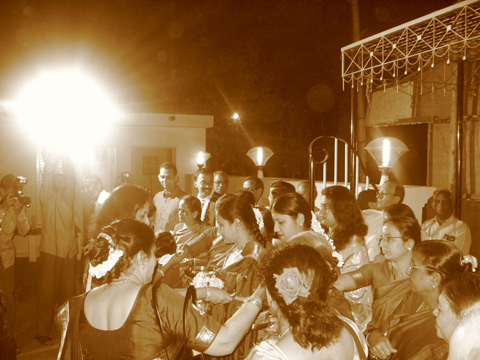
Both sides exchanging flowers

Anupama's parents performing some poojas
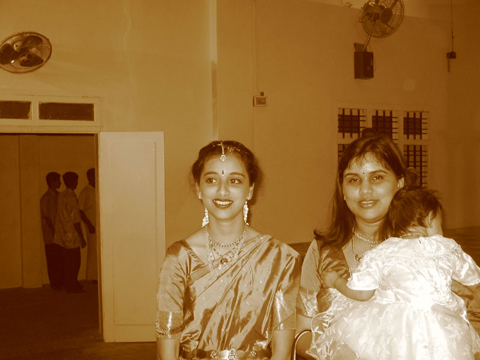
Anu, her eldest sister Seema and her baby Anoushka.
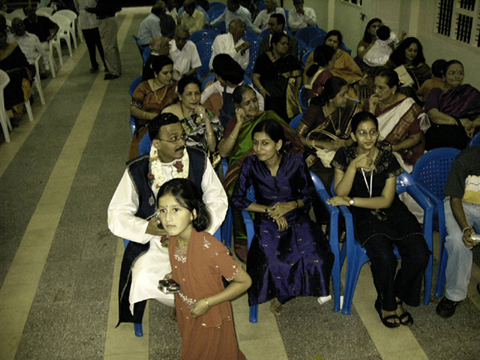
Me with my cousins, Madhuri (in red), Swapna (next to me) and Pallavi.
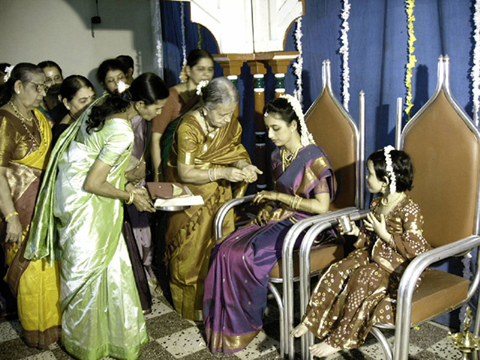
My aunts blessing Anupama. The little girl next to her is Neha, Anu's niece
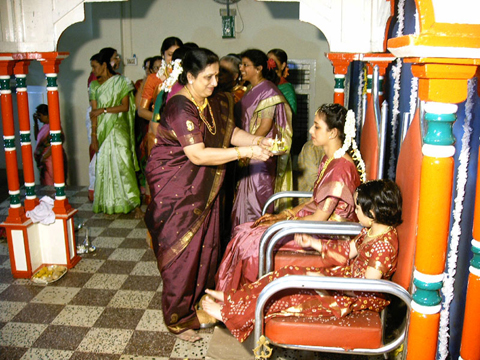
Anu's mother.
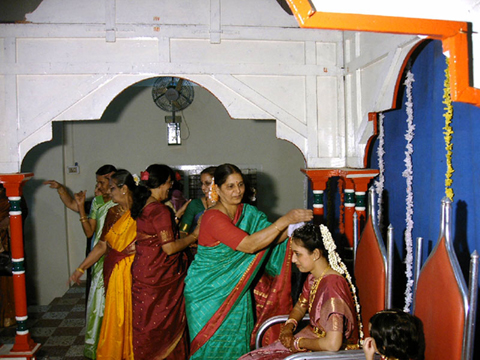
My aunts
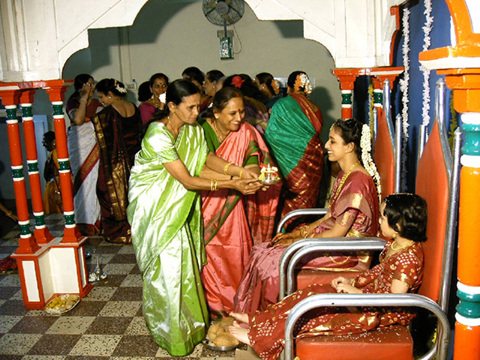
More Aunts

Anu's father offering sweets to Sachin and me
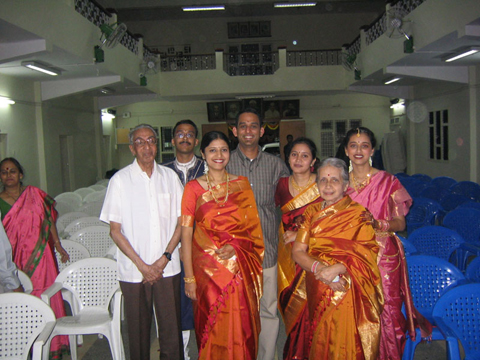
My father's eldest brother and his family with Anu and me

Nervous smiles, "We are getting married tomorrow" :-)
Satya Naranyan Pooja
Shri Satyanarayan is none other than Lord Vishnu and his pooja is often called a vrita or a vow and is observed on full moon days, sankranti days or even on new moon days. The most auspicious days are the poornimas of Chaitra, Vaishakh, Shravan and Kartik. It is not an expensive religious programme, as the prasad consists of €˜sapat€™ made up of wheatflour, sugar and a little ghee. With the help of a priest who has to read the story of Shri Satyanarayan whole pooja should be over within a couple of hours. Among the GSBs nowadays, soon after the wedding ceremony, the next day or the third day with the newly wed couple at the pooja, the vrita is invariably observed without any exception, popularly calling it €˜dev€™. Satyanarayan is regarded as the remover of all difficulties and so nowadays his pooja is performed, also as a panacea for all problems and difficulties.
The whole €˜vrita€™ is nothing but €˜shravan€™ or listening to the devotional stories of the greatness of God whose grace alone can and will bring us happiness.There are several stories known as Katha which the priest will read out for us as a part of the worship that tell us ignoring God or His devotees will bring in untold miseries but when we rectify the mistakes on our part and do not repeat them, such actions will please God. This is the central theme of Shri Satyanarayan Pooja that will inculcate devotion in us.
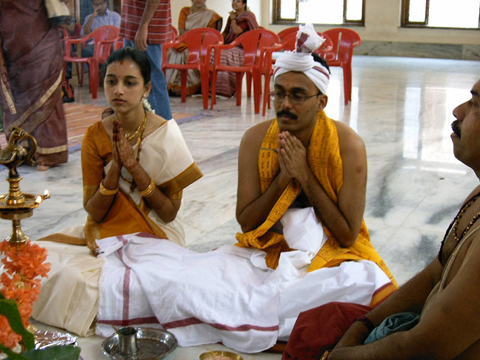
Anupama and me during the Pooja
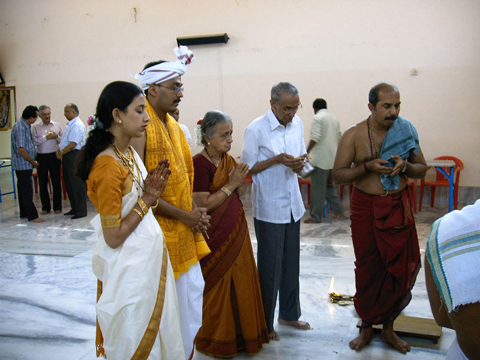
Anupama, me, my aunt and uncle during the Pooja
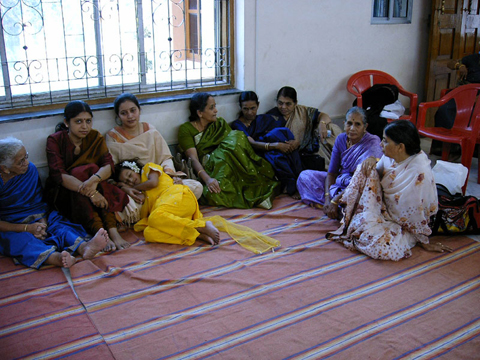
Some of my relatives
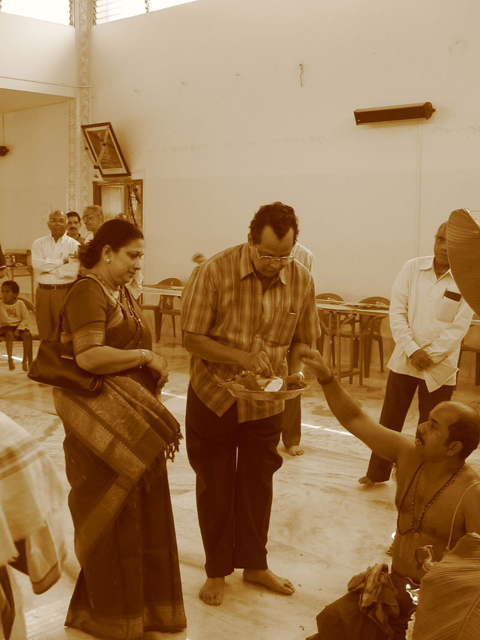
Anupama's Parents
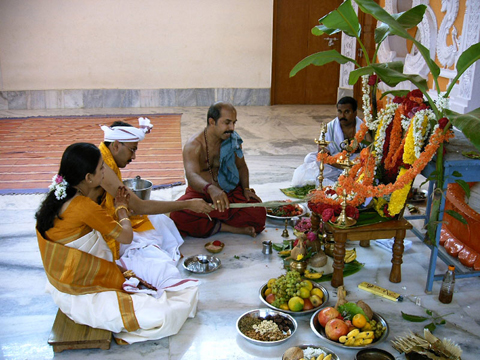
Anupama and me during the Pooja
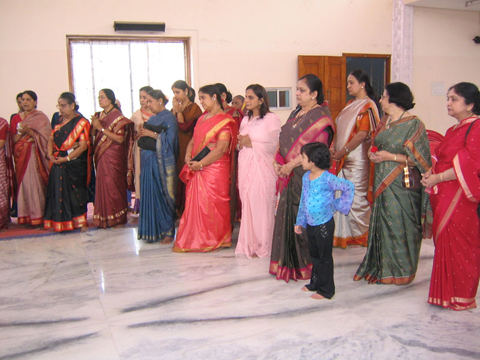
All the ladies in their lovely sarees
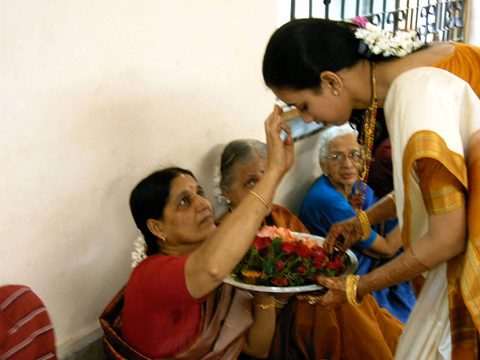
My aunt applying kumkum to Anupama
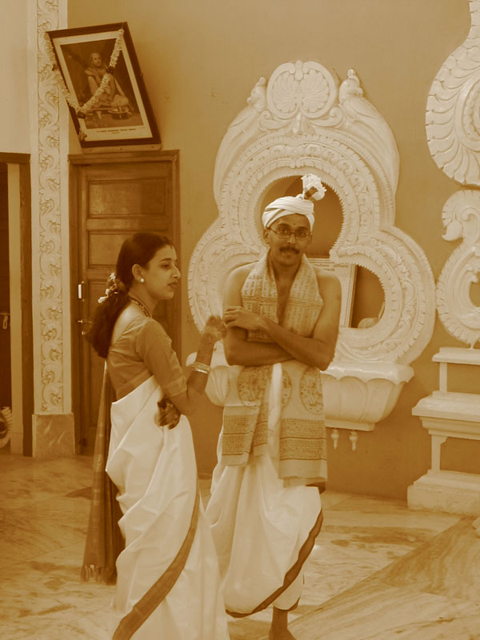
Anupama and me during the Pooja
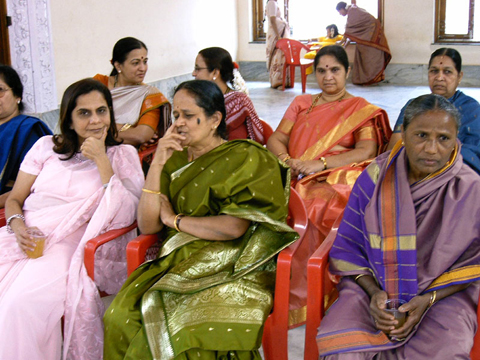
More relatives
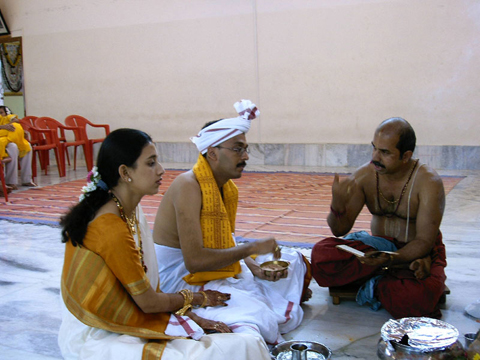
Anupama and me during the Pooja
Reception
We had a small reception at the Atria Hotel. A few friends and family members attended this function.
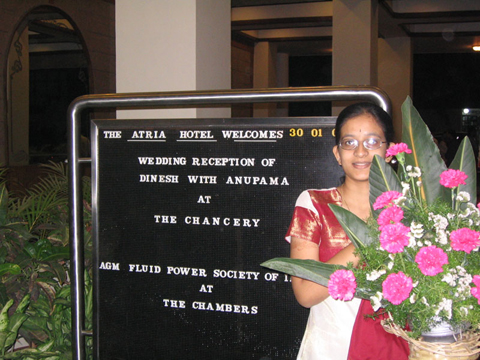
My cousin sister Pallavi with flowers

Anu and me posing for the photographer. Look at my outfit!!

More posing

My mother's aunt and her sons
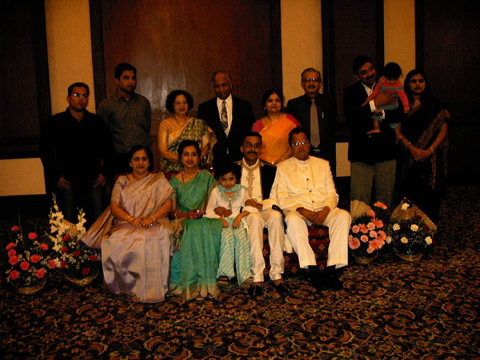
Anupama's family
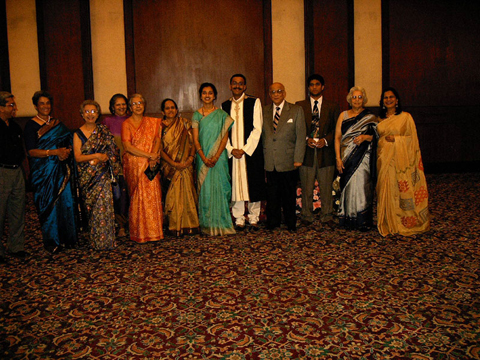
My neighbours from my Bangalore apartment
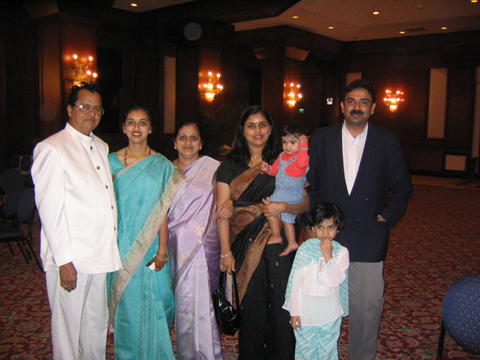
Anu's father, Anu, her mother, sister Seema, Anoushka, Brother in law Prem and Neha.

My cousins Vikas and Madhuri
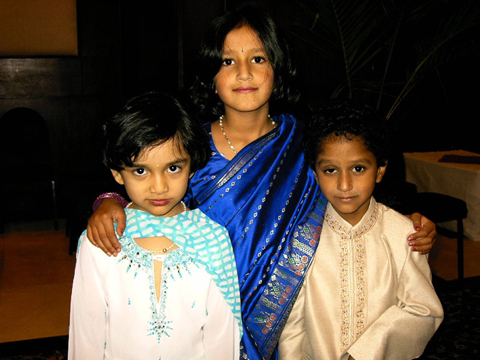
Neha, Madhuri and Vikas

My brother Sachin and my mother
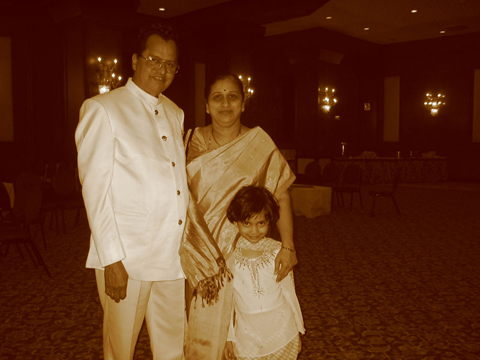
Anu's parents and Neha
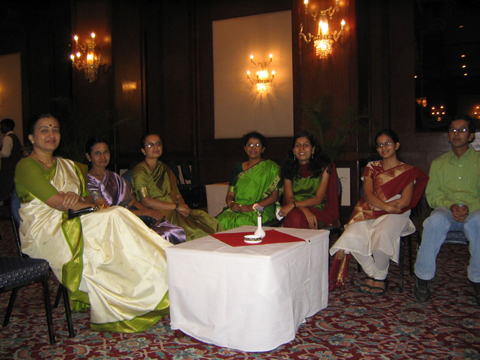
More relatives
Urdha Moortu
Urdha-moorthu is a traditional and religious ceremony performed by the bride and groom in their respective homes. The bride seats herself next to a stone grinder and with the help of other unmarried sisters and cousins grinds the 'urad dal' (type of lentil) and 'moong dal' (type of lentil) on the round stone grinder. The groom and his family are invited to this function.
The groom does the same in his house and invites the bride and her family to the function. The family priest performs the puja of the nine planets or the 'navagraha puja' after the 'urdha-moorthu'. After the puja, the groom dresses himself like a pilgrim, wearing a 'veshti' (dhoti), 'chappals' (slippers) holds an umbrella and makes preparations to embark on a 'mock' pilgrimage and remain celibate for life! At this point the bride's father pleads with him not to go on the pilgrimage and asks him instead to accept his daughter's hand in marriage! After much cajoling the 'pilgrim' accepts and returns to get married!
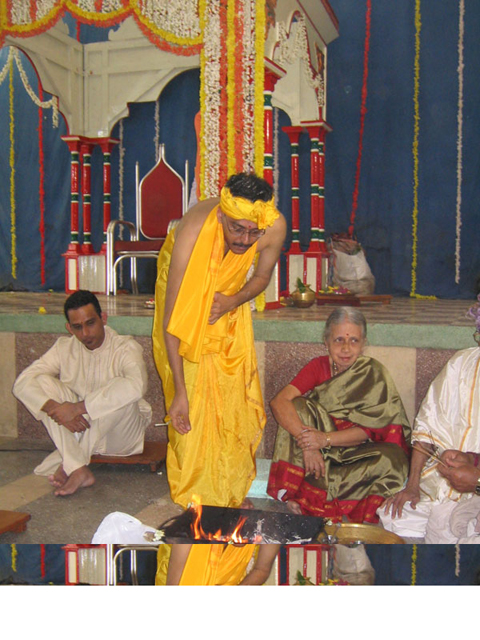
Me conducting the Pooja
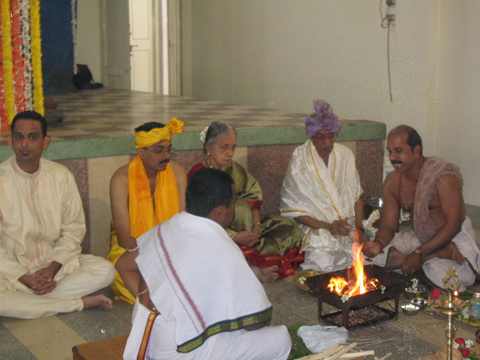
My aunt and uncle along with the priest (Bhatji)
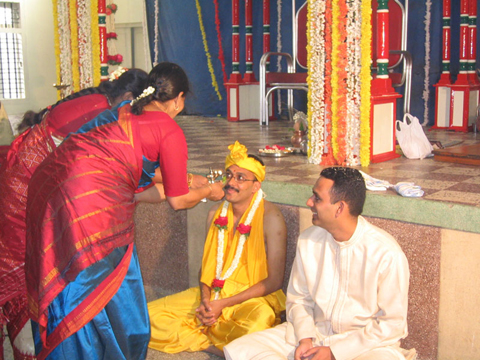
My aunts blessing me
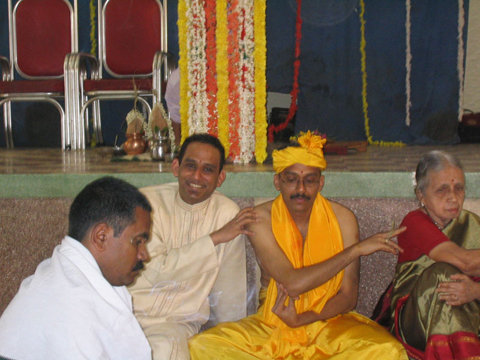
My brother finds this funny. Well, He's next!!!!
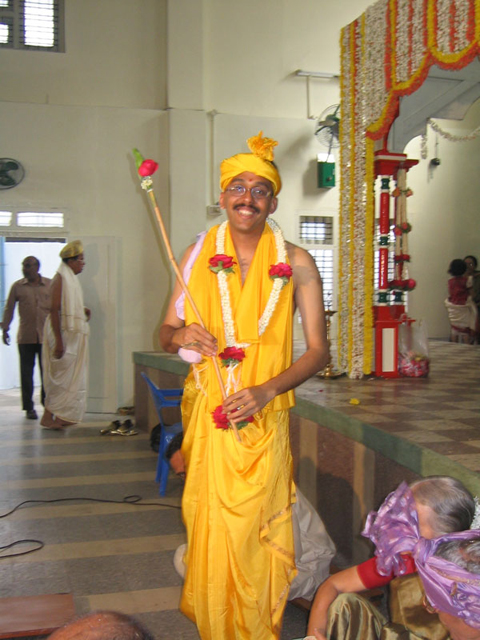
Me, getting ready for my pilgrimage of celibacy. Thats my father in law in the background, checking with Anupama if he should stop me. :-)
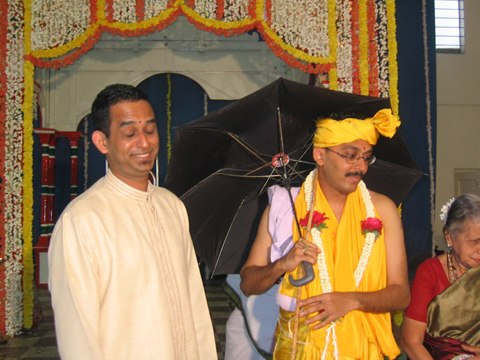
Did I just poke my brother in the eye with my umbrella?
Wedding Ceremony

Every Hindu is expected to cleanse and purify his body and soul through certain rights called Samskaras . These play and important role in man's life. The Hindu marriage is one of those sacraments. It is a pledged union of a man and a woman with the intent to follow the path of righteousness. The Hindu marriage ceremony or Vivaha is based on and adopted from the Rig Veda, one of the most ancient religions and philosophical scriptures and is considered to be very sacred. Though the Vedas are over 5000 years old, the truth contained in them is ever fresh and valid.
Naandi
This is a simple but important ritual consisting of a 'puja' (prayer) and is performed ten days prior to the actual wedding ceremony. The 'puja' is performed separately in both homes. The purpose being to negate the ill effects of any deaths in the family so that the marriage ceremonies may carry on without any obstacles.
Mehndi
Mehndi is the traditional art of adorning the hands and feet with a paste made from the finely ground leaves of the henna plant. The term refers to the powder and paste, and the design on the skin, as well as the party or ceremony. Henna is a small shrub called hawsonia inermis, and is also know as Henne, Al-Khanna, Al-henna, Jamaica Mignonette, Mendee, Egyptian Privet, and Smooth Lawsonia. Henna grows in hot climates and is found in India, Pakistan, Malaysia, Persia, Syria, Egypt, Morocco, Sudan and other North African, Asian and Middle Eastern countries. The leaves, flowers, and twigs are ground into a fine powder, then mixed with hot water. Various shades are obtainable by mixing with the leaves of other plants, such as indigo. Tea, coffee, cloves, tamarind, lemon, sugar, and various oils are also used to enhance the colour and longevity of design.
Phool Muddi
The father of the bride receives the groom at the entrance of the 'pandol' and the bride's mother performs the traditional 'aarti' for him. The groom is then seated and the bride's father washes his feet and ties the sacred thread or 'jhanava' on him. The bride is received by the groom's mother, who adorns her hair with flowers, performs an 'aarti' for her and showers her with rice. The showering of rice is known as the 'sesha'. She the invites the other married ladies or 'sumangalis' to come and bless her future daughter-in-law.
Urdha-moorthu is a traditional and religious ceremony performed by the bride and groom in their respective homes. The bride seats herself next to a stone grinder and with the help of other unmarried sisters and cousins grinds the 'urad dal' (type of lentil) and 'moong dal' (type of lentil) on the round stone grinder. The groom and his family are invited to this function.
The groom does the same in his house and invites the bride and her family to the function. The family priest performs the puja of the nine planets or the 'navagraha puja' after the 'urdha-moorthu'. After the puja, the groom dresses himself like a pilgrim, wearing a 'veshti' (dhoti), 'chappals' (slippers) holds an umbrella and makes preparations to embark on a 'mock' pilgrimage and remain celibate for life! At this point the bride's father pleads with him not to go on the pilgrimage and asks him instead to accept his daughter's hand in marriage! After much cajoling the 'pilgrim' accepts and returns to get married!
Mantap Pooja
The bride applies Kumkum and Sandalwood paste to the 4 pillars of the Mantap and offers prayers. Next comes the wearing of the Dharemani , a black bead ornament by the bride. This ornament is considered very sacred by a married woman and she wears it throughout her life as a mark of her being married
Kanya Agamana
The maternal uncle of the bride brings the bride to the mantap by holding her hand. Malasamparana - exhanging of garlands. The bride and the groom are made to stand of small heaps of rice grains, the boy facing east and the girl facing west. A cloth is held separating both of them. The priest then recites the sacred mantras invoking the ancestors of both the families. The bride and the groom proclaim their love and acceptance of each other by bestowing a garland on one another. This is the first step in their unity and the exchange symbolises the unification of their hearts. They sprinkle rice grains on one another.
Kanya Daan
In this ceremony, the bride is given away in marriage. The bride's parents give their daughter as a diving offering to the groom to fullfill the obligations that are social, ethical and moral. The bride's parents offer prayers to their Gurus and elders and seek their blessings.
Agni Prathistra The blessing of the God of Fire, Agni are invoked among Hindus. All solemn tites are incomplete without the performance of the Homa . An atmosphere of purity and spirutuality is created by the burning of the fragrant herbs and ghee to the tune of mantras. Fire is considered to be the most sacred because it is the giver of both Light and Energy. Panigrahana and Saptapadi are the fire rituals.
Shri Satyanarayan is none other than Lord Vishnu and his pooja is often called a vrita or a vow and is observed on full moon days, sankranti days or even on new moon days. The most auspicious days are the poornimas of Chaitra, Vaishakh, Shravan and Kartik. It is not an expensive religious programme, as the prasad consists of €˜sapat€™ made up of wheatflour, sugar and a little ghee. With the help of a priest who has to read the story of Shri Satyanarayan whole pooja should be over within a couple of hours. Among the GSBs nowadays, soon after the wedding ceremony, the next day or the third day with the newly wed couple at the pooja, the vrita is invariably observed without any exception, popularly calling it €˜dev€™. Satyanarayan is regarded as the remover of all difficulties and so nowadays his pooja is performed, also as a panacea for all problems and difficulties.